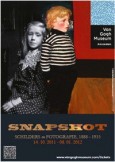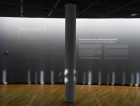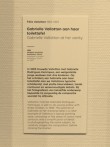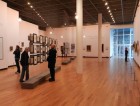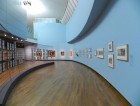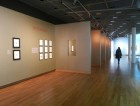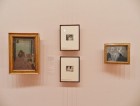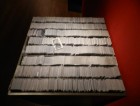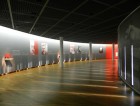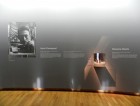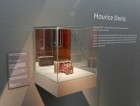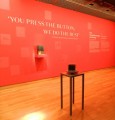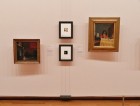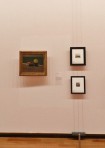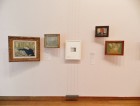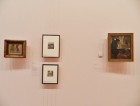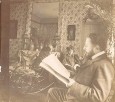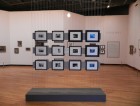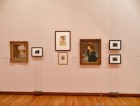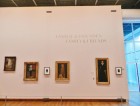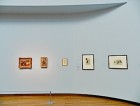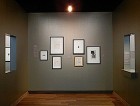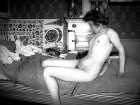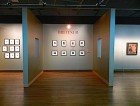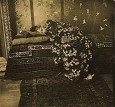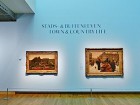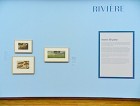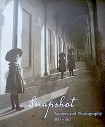The browser will either open the file, download it, or display a dialog.
Snapshot: Painters and Photography, 1888-1915
Van Gogh Museum, Amsterdam
October 14, 2011 – January 8, 2012
Snapshot: Painters and Photography, Bonnard to Vuillard
The Philips Collection, Washington, DC
February 4 – May 6, 2012
Indianapolis Museum of Art, Indianapolis, IN
June 8 – September 2, 2012
Catalog
Snapshot: Painters and Photography, 1888–1915
Edited by Elizabeth W. Easton, with contributions by Clémment Chéroux, Michel Frizot, Todd Gustavson, Françoise Heillbrun, Ellen W. Lee, Anne McCauley, Saskia Ooms, Katia Poletti, Eliza Rathbone, and Hans Rooseboom.
New Haven and London: Yale University Press, 2011.
248 pp.; 285 color illustrations, hard-cover, plates, artist biographies, exhibition checklist, index. photo credits.
€ 35,00/ $ 49.70
ISBN 978 90 79310 28 9
Snapshot: Painters and Photography, 1888–1915 was an exhibition devoted to a group of seven post-impressionist painters and printmakers who actively engaged in amateur photography (fig. 1). Most of them recorded their daily activity; however, they also used the camera to take pictures that would act as sketch material for future art works on canvas or paper. The term snapshot designates a picture “taken quickly and without careful aim” in Todd Gustavson's words, a sort of picture born with the advent of amateur photographic cameras and highly utilized by the seven artists included in this exhibition (17). As a result, the exhibition shows a great collection of more than two hundred snapshot photographs rendering the artists's private daily life and approximately sixty art works (paintings, drawings, and prints) that evidence the interaction between the art works and the photographic medium. In spite of the personal use for which the pictures were taken, family gifts and exhaustive research have unmasked a practice more common than generally acknowledged by late nineteenth-century and early twentieth-century artists. Therefore, the exhibition should be seen as the first attempt to publicly display this “private” photographic material next to the artists's paintings, drawings, and prints, and by doing so, bring new light to their artistic production.
The seven artists displayed in the exhibition were chosen for their use of the camera during the same period. Included in the group were four artists of the Nabi movement (from the Hebrew word for “prophet”): the French Félix Vallotton (1865–1925), Édouard Vuillard (1868–1940), Maurice Denis (1870–1943), and Pierre Bonnard (1867–1947). Encouraged by the art of Paul Gauguin, they aimed at painting bolder and simpler images in a more primitive manner. Henri Rivière (1864–1951), a French artist close to the Nabis, and the Belgian Henri Evenepoel (1872–1899) worked in Paris and developed a clear taste for the shadow theatre that can be perceived in their pictures. George Hendrik Breitner (1857–1923) was Dutch and the only artist who did not remain in Paris; instead, his street scenes reflect life in Amsterdam though, like the rest of the artists shown, he also engaged in photographing nudes and/or family.
The beginning and ending dates of the period covered in the exhibition, 1888–1915, correspond to the birth of the first Kodak compact and easy-to-use camera and to the beginning of World War I, respectively. Both dates concern revolutionary moments in the history of photography in their own way. The initial date refers to the first time that amateur photographers could carry the camera with them and take pictures by simply holding it with their hands and pressing a button. The convenience of George Eastman's new device led to such a photographic boom that five thousand cameras were manufactured during the first year of production, sold at a price of $25 (about $600 in 2012 money) (16–17). The second date marks the moment in which the Great War had already begun, and photographers changed the way of using this medium thanks to new technical developments.[1] Interestingly enough, the exhibition's title Snapshot: Painters and Photography, 1888–1915 switched to Snapshot: Painters and Photography, Bonnard to Vuillard at the two American venues; the artists Bonnard and Vuillard are “beloved artists in the United States,” states guest curator Elizabeth W. Easton, and their presence in the title appeals to the audience from Washington and Indianapolis more than the aforementioned dates.[2]
Snapshot was a richly informative and visitor-friendly exhibition. The information was introduced progressively, first the thesis statement of the show, second the artists and their photographic cameras, and third and last, the artists's oeuvres with their individual and their shared characteristics, which in turn linked the artists together again. Data was made available both on wall texts concerning the sections and artists, and on labels for the exhibited works with extensive biographic and technical remarks (figs. 2 and 3). Nonetheless, the exhibition spoke for itself, creating visual frameworks for the visitor. In order to achieve this, the two core spaces were divided into three visual sections: "Family and friends" (lower floor) exhibited mainly interior scenes from the artists's daily life, and the room—painted in soft pink color—was partly illuminated by two rows of low lights next to the fences where the photographs hung, providing an overall warmth (fig. 4). The section "Town and Country Life" (upper floor) was illuminated with white light and painted in sky blue suggesting an open air space, and displayed urban and rural exterior scenes (fig. 5). Finally, the section "Nudes" (upper floor) recreated an intimate sphere with little sombre, squared pseudo-rooms filled with photographs, drawings, lithographs, and paintings of female nudes (fig. 6).
An astonishingly original installation design, developed by Petra Blaisse's studio Inside Outside, allowed the organizers to hang thematic groups of works together on the wall as if they were facing each other, as a means of isolating them from other groups (fig. 7). This device was repeated several times along a great horizontal wall and created a sense of movement as well as intimacy among the selected artworks. Furthermore, Easton explains how, "the decision about the spaces has a lot to do with the challenging architecture of the Van Gogh Museum temporary exhibition galleries, especially when dealing with such small objects in such a large space."[3] This was the case with the rows of pictures displayed in the center of the lower floor room, which needed light, but not a direct spotlight that would damage them. The dilemma, explains the Head of Exhibitions of the Van Gogh Museum, Edwin Becker, was solved by using powerful halogen spotlights directed towards the opposite wall painted in pink.[4] With this, the wall reflected the light and illuminated the photographs indirectly. Another ingenious initiative was providing the visitor with little augmenting lenses to better appreciate the photographs (fig. 8). Pictures such as those by Pierre Bonnard, measuring 4 x 5.1 cm., were difficult to fully enjoy with the naked eye, and the lens helped the viewer to pay attention to the pictures with renewed interest.
The show welcomed the visitor with a gallery introducing the core actors: the artists and their cameras (fig. 9). The cameras these artists used were a recent invention in the short history of photography. This began with the development of photography by Louis Daguerre (1787–1851) in 1839. The daguerreotype, the forerunner of modern photographs, was captured and fixed in a camera obscura. Shortly thereafter, artists became fascinated with the new medium's capacity to record reality. Gustave Courbet (1819–77) was "one of the first painters to absorb the new medium's stylistic and technical potential" claims Kate Taylor.[5]He not only used purchased nude photographs as the basis for his paintings, but also embraced photographic projects to record his painted work.[6]Moreover, the Pre-Raphaelite Brotherhood used photography, as did naturalist and impressionist artists, although each movement emphasized different qualities of the medium. However, the invention of the first compact camera in 1888 had extraordinary consequences for visual artists; they could take their own photographs instead of relying on other photographers's pictures or acquiring professional equipment that was too expensive or cumbersome to carry. The new, relatively small and portable camera forever changed the relationship between the visual artist and photography.
The introductory gallery displayed the Van Gogh Museum's collection of nineteenth-century Kodak cameras, together with the artist who had used that model in the past.[7] Henri Evenepoel owned a Kodak Pocket Model from 1896, which can be seen in a self-portrait staged with several mirrors to produce a play of reflections (fig. 10). The same camera was used by Vuillard, Breitner, Denis, and Bonnard, who later purchased the Kodak Folding Pocket Camera, first available in 1898, (fig. 11). In order to understand how these cameras worked, the organizers reserved the last part of the gallery to display the instruction booklet that the Kodak company camera supplied to its users (fig. 12). Kodak's slogan "You press the button, we do the rest" came to suggest the easiness of the medium and the care offered by the post-sale service, which processed the photographs mechanically. With this, the amateur photographer did not even have to go through "messy home processing" and the professional photofinishing industry began (16). One of the booklet's pages reproduced on the wall showed how cameras worked: they were held at waist height and activated by a button. The waist-level perspective differed greatly from that of the human eye, and as Gustavson puts it, "is readily apparent in many works of art" (21).
Distortions were a common feature in the pictures of the seven artists of the show. According to Clément Chéroux, "it is perhaps the lack of technical knowledge that most determined the appearance of their photographs. The inexperience of these amateurs led to many small errors [...] that ultimately gave their work a visual quality by default, an unintended artistry" (43). This “unintended artistry” nevertheless suited the artistic aspirations of the Nabis. On the lower gallery floor, the family photographs of Denis, Vuillard, and Félix Vallotton as well as Evenepoel appear in all their casualness. The painter, illustrator, and wood carver Vallotton exploited the possibilities of perspective to achieve the aforementioned artistry. His painting Gabrielle Vallotton Doing her Nails was inspired by the photograph hanging next to it; it shows, however, a flattened version of a similar scene, with Gabrielle sitting immediately behind the table in the foreground (fig. 13). She pops out from the background thanks to the pinkish-red jacket she is wearing and the back wall appears too small to be realistically depicted, evidencing the addition of a spatial distortion by being observed with a camera. This image denotes as well the influence of Japanese woodcuts as—in other Nabis artists—due to its overall flatness and the superposition of color to create visual depth. Moreover, the painting Sur la plage (On the Beach) exhibited next to the pictures taken at the beach in Etretat suggests the idea that the artist was kneeling or sitting down behind the three figures depicted on the board, showing a rough schematic painterly quality, very likely taken from out-of-focus photographs (fig. 14).
The figure of Vallotton brings to the fore the sensitive issue of painters using photographs as preparatory notes. Kattia Poletti notes that Vallotton's archives included scarcely twenty photographs and mentions "the scathing criticism he received when it became known that he had painted a nude from a photograph" as the reason for the destruction of the rest of the pictures (177). This comment grounds the tension felt by painters towards revealing their photographic sources and explains the consequent invisibility of these sources. Despite this, the status of photography as a mere reproductive means began to change in the late 1880s. In a book entitled Naturalistic Photography (1889), Peter Henry Emerson advocated “Picture Taking,” understood as a photographic method that would follow its own rules instead of those of art. As Margaret F. Harker explains, Emerson "placed emphasis on the aesthetic, ethic and technique of photography as an independent art. . .," beginning a revolution that would achieve artistic recognition for photography only well into the twentieth-century.[8] In the meantime though, artists had to resign themselves to hiding their use of photographs as an artistic medium, as the seven concerned artists in this show did.
Maurice Denis, married to Marthe and father of their seven children, repeatedly photographed his family. The photograph portraying Marthe in a Bonnet prefigures the paintings surrounding this picture in the exhibition (fig. 15). These are La capeline rose à Perros (The Pink Cape at Perros) and Portrait de Marthe à voilette blanche (Portrait of Marthe in a White Veil), where the outstanding white details of Marthe's veil reveal the contrasting character of light in black and white photographs. The presence of another picture of Marthe, now sewing at home, suggests an intimacy between the photographer and the subject, a photograph only achieved with a high level of familiarity (fig. 16). The emotion expressed in the pictures led Marthe not only to develop the pictures herself, but also to make family albums with many of the 2,689 printed photographs that her husband took.
Édouard Vuillard devoted his nearly two thousand photographs to capturing intimate scenes of his family and close friends. In part due to the death of his father when he was fifteen years old, Vuillard remained physically and emotionally attached to his mother until her death in 1928. This maternal connection is illustrated with the painting Interior, Mother and Sister of the Artist; the mother dominates the main central space in a black dress while his sister is literally dissolved into the patterned wallpaper with a windowpane checked dress (fig. 17). Vuillard's horror vacui manifests as well in the photograph Thadée and Misia Natanson in the Salon, Rue St. Florentin, where Misia would disappear in the background of her salon if it were not for the carefully composed view (fig. 18). Even though Thadée Natanson was the publisher of La Revue Blanche where Vuillard often worked, the artist felt “sensualities. . . and conflicting desires” towards Natanson's wife, Misia (194). In this photograph, despite Thadée's imposing foreground pose, Misia's position in the center of the composition is the true focus for the artist. She is framed by the painting, the door, and the mirror around her, and by the angle created by her husband's body and the newspaper he holds. Another important aspect that the juxtaposition of paintings and photographs illustrates is that Vuillard carefully maintains the intimacy of the photos by creating his paintings at a similarly small scale, as if inviting the viewer to get closer to the images to better understand them and participate in the scene (fig. 19).
Enthusiastic enough about the new medium to take some 875 photographs in two and a half years was Henri Evenepoel, a Belgian-born artist who settled in Paris in 1892 (127). Evenepoel was not only interested in the photographic results, but also aimed at mastering the photographic tool. Proof of this is revealed by several self-portraits taken with the help of a mirror to experiment with variations of light, perspective, distance, and composition (fig. 20). The taste for experimentation also led him to take spontaneous snapshots of the street. Influenced by the Impressionist paintings of Edouard Manet and Edgar Degas, the Belgian would enjoy capturing movement and cropping figures. His other passions, however, were his cousin Louise—with whom he had a son, Charles de Mey—and the children. Numerous photographs as well as paintings bear witness to this, denoting the tenderness with which Evenepoel captured the semblance of his beloved ones (fig. 21). They clearly pose in the pictures, sometimes in a highly orchestrated manner, as, for example, the portrait of his nephew Albert Devis, which is based on earlier portraits by Manet (fig. 22).
Bonnard and Breitner practised photography with highly intimate pictures as well as open-air snapshots. In the upper-floor of the exhibition space, both facets of these artists's works were displayed. Bonnard used the camera for snapshots framed off-center, and truncated or out of focus pictures (fig. 23). Françoise Heilbrun remarks that Bonnard was primarily a painter, and while he did not technically experiment with the camera, he "recognized how originality of vision was more important than technical expertise." What the painter achieved in Heilbrun's words was "transforming the everyday into something poetic and wondrous. Usually, he captured his subjects at a distance, accentuating the effect of mystery." (63–64). Indeed, Bonnard's frozen images of street life add a new dimension to daily routine by flattening the surfaces as in The Little Laundress, or using a high perspective in Narrow Street in Paris, or accentuating the contrast of light and shadow in The Cab Horse (fig. 24). On the other hand, Bonnard developed an abundant production of nude photographs with Marthe de Méligny as his model. The nudes—displayed at the show in the little darkened rooms—are innovative for their radicalism, as Anne McCauley puts it (49) (fig. 25). This translated into uncommon vantage points, harsh lightning, and explicitly sexual exposés. To illustrate this, the photograph Marthe Seated in Profile on the Bed shows an ungraceful, but sexually charged posture that Bonnard composed as a preparatory sketch for the lithograph Limbes (Limbo), which accompanied Paul Verlaine's erotic poem with same title in his book, Parallèlement (In Parallel) (fig. 26).
Several of Breitner's nude photographs could be enjoyed as well in the little sectioned off rooms where the rich variety of models he photographed could be appreciated (fig. 27).[9] Specifically, the case of Geesje Kwak, a teenager and hat-seller, appears remarkable, as she became one of his favorite models. Born in 1877 in a little Dutch village, she moved to Amsterdam in 1893 where she became Breitner's “Japanese muse.” As could be seen in the show, she frequently posed wearing a kimono in a Japoniste environment, which then became a painting of the exact same scene (figs. 28 and 29). The recurrence of these motifs in his paintings reflects the popularity of Japonisme in the late nineteenth century, and contributed significantly to Breitner's commercial success at a young age.[10]But Breitner was also an avid street photographer and proof of that are the several paintings that hung in the section "Town and Country Life." The painting Bridge over the Singel near Paleisstraat in Amsterdam is the product of a snapshot taken when pedestrians walked towards the artist on the bridge (fig. 30). Cropped and blurred, the image suggests a spontaneous character that did not always correspond to reality; curator Hans Rooseboom states that the artist so carefully staged his pictures that he even asked models to pose "as if they were walking" (88), which could have been the case with the woman in the center of the artwork.
Finally, Henri Rivière—print maker, stage designer, water-colorist, collector, and author—was presented as a peculiar case in the exhibition. He was close to the Nabis, yet not part of their group; he was an amateur photographer, yet his photographs were different from those of the other six artists due to his choice of motifs and his higher technical understanding of the photographic process. Artistically trained in the atelier of Emile Bin for only two years, 1879–80, Rivière was under the spell of two artistic traditions: Japanese prints and the shadow theatre. The artist developed a fascination for Japanese art that led him to experiment and teach himself the technique of woodcarving. He started in 1892 with a series of six woodblock prints called La mer, études des vagues (The Sea, Studies of Waves) and used the same technique again in other lithograph series like La féerie des heures (The Magic of the Hours) (fig. 31).
The Japanese influence also appeared in the shadow theatre that Rivière staged at the Paris cabaret Chat Noir (Black Cat), where he exploited his skills in making well-defined silhouettes. Consequently, Rivière's more than three hundred snapshots supply the viewer with strong silhouettes and rich contrasts. In 1889, Rivière was invited, in conjunction with the whole staff of the Chat Noir, to visit Gustave Eiffel's tower before it was finished. The artist took the camera up in the tower, seeking the inner life of the building process and the construction workers. What resulted from those pictures was the album of etchings Les trente-six vues de la Tour Eiffel (Thirty-six Views of the Eiffel Tower), a work reminiscent of geometric abstractions worthy, as Ellen W. Lee put it, "of the twentieth-century avant-garde" (156).
The exhibition showed how the late nineteenth-century painters experimented with the snapshot, together with more carefully staged images too. The core idea of the exhibition was clear: although we have learned to admire these artists for their prints and paintings, there was a great collection of self-produced photographic material that remained hidden during their lifetimes, but which strongly interacted with their known artistic work. Moreover, several other issues arose in the show, such as the strong influence of Japanese art, the exact likenesses between photographs and paintings, the creation of family albums, and the new harshness of female nude pictures. In addition, the dissemination of information from the general wall texts to the highly specific object labels provided every visitor with the desired level of scholarly depth. The fantastic exhibition catalogue offered even more information if a viewer was interested (fig. 32). No more needs to be said other than Snapshot: Painters and Photography, 1888–1915 was an enjoyable and enriching exhibition as many more exhibitions should be.
Alba Campo Rosillo, MA
info@albacampo.com
[1] As Elizabeth W. Easton puts it: “From the First World War, photography took on a slightly different trajectory, and the main thrust of our group really concentrates before that date.” Elizabeth W. Easton, “RE: Snapshot in Amsterdam,” e-mail to the author, February 13, 2012. The date 1915 does not mark the precise beginning of the Great War (1914) but the changes in the photographic trajectory that followed.
[2] Ibid.
[3] Ibid.
[4] Edwin Becker, interview by Alba Campo, December 14, 2011.
[5] Kate Taylor, “Courbet's Eye and the Camera,” New York Sun, Feb. 25, 2008, http://www.nysun.com/arts/courbets-eye-and-the-camera/71804/ (Mar. 15, 2012).
[6] Metropolitan Museum of Art, “New Visions: Courbet and Photography” in Gustave Courbet, (Metropolitan Museum of Art, 2008), http://www.metmuseum.org/exhibitions/listings/2008/
gustave-courbet/new-visions-courbet-and-photography (Mar. 15, 2012).
[7] Edwin Becker explained that the cameras had been especially purchased for the exhibition; Becker, interview by Alba Campo, December 14, 2011.
[8] Margaret F. Harker, Henry Peach Robinson: Master of Photographic Art, 1830–1901 (New York: Blackwell, 1988), 78.
[9] Mayken Jonkman's study of Breitner's letters revealed the large number of models he worked with and offers insight into the lives of a few of them. See Mayken Jonkman, “'Een zee van modellen'. George Hendrik Breitner, zijn 'Japanse vrouwtjes' en andere wetenswaardigheden uit het negentiende-eeuwse modellenvak” RKD Bulletin 1 (2011): 27–33.
[10] Chris Stolwijk relates that Breitner's work was acquired for the Dutch state collection between 1875 and 1901, noting that this type of recognition was usually reserved for much older artists. See Uit de schilderswereld: Nederlandse kunstschilders in de tweede helft van de negentiende eeuw (Leiden: Primavera Pers, 1998), 87.


